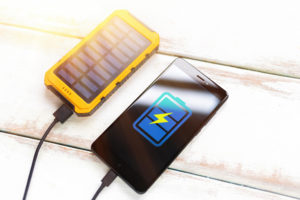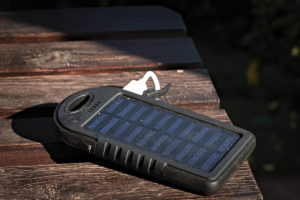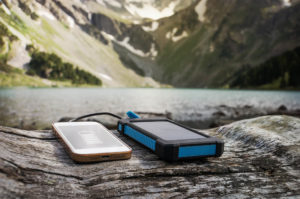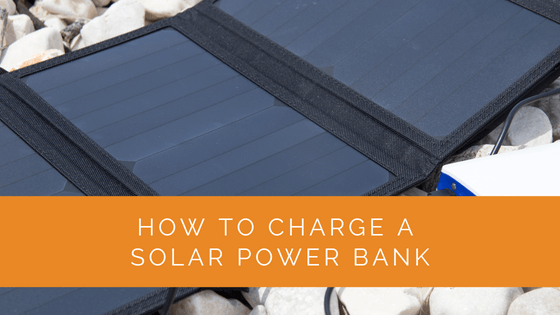Have you ever felt anxiety when your phone runs out of juice? Guess what? Feeling heightened anxiety as you move farther from your power socket is normal. Perhaps it’s also why packing an additional power bank is more vital than an extra juice pack when traveling or camping outdoors.
Solar power banks are a great way to charge your devices when outdoors. These solar tools have become an indispensable essential to lengthen the life of your device(s). They are portable, lightweight, and compact too. The best part is that they can charge anything from car batteries to laptops and mobile phones.
Now, your solar power bank can charge multiple devices, but how do you charge the solar power bank?
To charge your solar power bank, you need direct sunlight, which usually takes between 30-50 hours to be fully charged. However, this number can go up or down depending on battery size and other variables.
Are you interested to know more? Continue reading this detailed guide and learn how to charge a solar power bank efficiently!
Contents
- 1 Key Takeaways
- 2 How Does Solar Power Bank Work?
- 3 When Can You Charge a Solar Power Bank?
- 4 Can You Charge Solar Power Bank In Indirect Sunlight?
- 5 Solar Power Bank Charging Time Calculator
- 6 Will Your Solar Power Bank Charge in Shade?
- 7 Should You Charge Solar Power Banks in Direct Sunlight?
- 8 How Can You Speed Up the Charging of Solar Power Banks?
- 9 How To Know When Your Solar Power Bank Has Fully Charged?
- 10 Case Study: Efficiently Charging a Solar Power Bank for Outdoor Adventures
- 11 Expert Insights From Our Solar Panel Installers About How to Charge a Solar Power Bank
- 12 Summing Up
Key Takeaways
- Solar power banks are portable and versatile tools for charging various devices using solar energy, including mobile phones and laptops.
- To efficiently charge a solar power bank, it needs direct sunlight, and the time required for a full charge can vary based on battery size and other factors.
- Charging in direct sunlight is the most effective method, and adding more solar panels and avoiding shade can speed up the charging process. Solar power banks typically indicate a full charge with LED lights or smartphone apps.
How Does Solar Power Bank Work?
Solar power banks come with in-built, rechargeable lithium-based batteries. These banks have solar panels attached to them, made of photovoltaic cells. When the sunlight hits the panels, the photovoltaic cells collect the photons and store them in the conductive plate.
The conducive plate uses these photons to create electricity and feed them to the rechargeable batteries. The batteries hold onto this electricity and keep them stored until needed.
Solar energy, without a doubt, is the most abundant and green energy source on the earth. Did you know that the sun is over 4.5 billion years old? Yes, that’s a lot, but you need not worry because it still has about 5 million years to go. So, if you’re considering investing in solar tools like solar power banks and chargers, you are on the right track to a more sustainable life.
You can also charge your solar power bank using a power socket. It’s a myth that solar devices require heat to charge, but they do not. Solar tools and devices depend on light rather than the sun’s heat to charge.
This is also why it’s always mentioned in the instructions manual to place the solar device in a location with ample direct sunlight.

When Can You Charge a Solar Power Bank?
Now that you know that the photons charge your solar power bank and not the heat, you can charge your solar bank anywhere. However, the location should have unobstructed sunlight exposure for optimum charging.
That said, it’s no use to charge your power bank in a location without sunlight, even if it’s the hottest hour of the day. Instead, try charging your solar devices before noon. Solar devices tend to collect more energy when the light energy is highest, before noon when the sun is at its peak in the sky.
Can You Charge Solar Power Bank In Indirect Sunlight?
Yes, you can charge your power bank in indirect sunlight, but it won’t be as efficient as direct sunlight solar charging.
When indirect sunlight hits the panel, the amount of energy the solar cells accumulate is also less. This results in less electricity generation, putting you in an energy crunch when you need to charge your devices while camping in the great outdoors.
Moreover, if the solar panel of your solar charger is small, it will charge very slowly and inefficiently in indirect sunlight. You’ll need to add a few more panels to optimum power bank charging to increase its charging capacity.
If additional panels are not an option, you can also try hanging the solar panels on your bag to increase its exposure to the sun.
Solar Power Bank Charging Time Calculator
Estimate how long it takes to fully charge your solar power bank in direct sunlight.
Estimates are approximate and depend on sunlight conditions, panel quality, and system efficiency.
Will Your Solar Power Bank Charge in Shade?
No, your solar power bank will not charge in the shade or on a cloudy day. To get better clarity on this subject, you first need to understand what ‘shade’ means here.
The ‘shade’ here denotes complete obstruction of sunlight, much like the shadow cast by opaque objects.
However, the same cannot be said about the shade of a tree because they don’t completely block the sunlight. You can still find sunlight piercing through it and forming small bits of light on the ground.
The sunlight blocked by a tree comes under reflected light, resulting in inefficient charging of your power bank. However, the shadow cast by an opaque body like a human is a shade, and you cannot charge your power bank in that shade at all.

Should You Charge Solar Power Banks in Direct Sunlight?
It would be best to charge your solar chargers in direct sunlight. The charging hours of solar banks depend on their battery capacity and size.
The battery capacity of a solar bank usually ranges between 15000 – 20000 mAh. Therefore, if your solar panel is compact, it can’t be fully charged via the sun’s energy alone.
Even manufacturers advise charging solar devices through USB ports after it has reached the 50% mark. This is also the case for even the best solar power banks.
Any solar or electronic device tends to charge quickly until it replenishes half of its energy. However, after the 50% mark, these devices tend to charge slowly because they have already accumulated the minimum reserve of energy they need to function.
How Can You Speed Up the Charging of Solar Power Banks?
Are you getting late for your camping trip, but your cell phone battery is dead? Don’t sweat; it’s for times like this that solar chargers and banks are the best savior.
Even if your solar bank has less charge and takes a long time to accumulate energy, here are a few tips to speed up how long it takes to charge a solar power bank!
More Solar Panels Are Better
The more solar panels the bank will have, the more energy it will collect. Many solar panels have a large surface for accumulating light particles.
Due to this, direct light hitting the solar panel also increases, resulting in faster and higher electricity generation. Hence, adding a few solar panels to your solar device can boost its charging and functioning capacity.
Avoid Shade
The importance of avoiding shade cannot be stressed enough. You can observe a tremendous change in the charging capacity of your solar devices by simply avoiding shade.
It also means that you may have to change the device’s position multiple times a day, depending on the hour and position of the sun. You can also attach your solar bank to your backpack while traveling to give it extra sun exposure and avoid shade simultaneously.

How To Know When Your Solar Power Bank Has Fully Charged?
Solar power banks usually have single LED lights that light up once the device has been fully charged. These LED lights help determine whether the power bank has any charge after charging your cell phones and mobile devices.
Although this is true for most solar power banks, some also have an app that tells you their charge level.
Case Study: Efficiently Charging a Solar Power Bank for Outdoor Adventures
Background
A group of outdoor enthusiasts contacted Solar Panels Network USA for advice on efficiently using and charging their solar power banks during extended camping trips. They wanted to ensure their devices remained charged without relying on traditional power sources.
Project Overview
Our team provided a detailed guide and hands-on demonstration on how to maximize the efficiency of solar power banks. The focus was on positioning, avoiding shade, and utilizing additional solar panels for faster charging.
Implementation
- Direct Sunlight Positioning: We emphasized the importance of placing the solar power banks in direct sunlight. Demonstrations showed how adjusting the position of the power bank throughout the day could maximize sunlight exposure.
- Avoiding Shade: The team provided tips on how to avoid shade from trees, tents, and other obstructions. This included moving the solar power bank periodically to ensure it remained in direct sunlight as the sun moved.
- Using Additional Panels: We suggested integrating additional solar panels to increase the surface area for capturing sunlight. This strategy proved effective in speeding up the charging process.
- Monitoring Charge Levels: The use of LED indicators and smartphone apps to monitor charge levels was demonstrated. This helped the group understand when their power banks were fully charged or needed repositioning.
Results
- Improved Charging Efficiency: By following the guidelines, the group experienced a significant improvement in the charging efficiency of their solar power banks. The power banks charged faster and provided reliable power throughout their trips.
- Sustained Device Usage: With fully charged power banks, the group could keep their devices powered, including smartphones, cameras, and portable lights, ensuring safety and connectivity during their outdoor adventures.
- Positive Feedback: The group reported high satisfaction with the ease and practicality of the methods taught. They felt more confident in their ability to maintain power for their devices using solar energy.
Summary
This case study demonstrates the effectiveness of strategic positioning, avoiding shade, and using additional solar panels to charge solar power banks efficiently. Solar Panels Network USA provided the group with practical, easy-to-follow steps, enhancing their outdoor experience by ensuring their devices remained charged. This approach not only ensured sustainability but also empowered the group with the knowledge to maximize their solar energy use effectively.
Expert Insights From Our Solar Panel Installers About How to Charge a Solar Power Bank
Charging a solar power bank efficiently requires direct sunlight. Positioning your power bank to get maximum exposure throughout the day will ensure it charges faster and more effectively.
Senior Solar Technician
Avoiding shade and using additional solar panels can significantly speed up the charging process of your solar power bank. Even on partly cloudy days, ensuring the panels receive as much light as possible is key to maintaining optimal charge levels.
Lead Solar Installer
Many solar power banks come with indicators like LED lights or smartphone apps to show when they’re fully charged. This feature is extremely useful for planning your energy needs while on the go.
Solar Energy Consultant
Summing Up
Solar power banks are essential if you’re an adventure enthusiast. You must place the device in a location with ample sunlight for a few hours to recharge your mobile phone indefinitely.
They are environmentally friendly, wireless, waterproof, and even have an LED flashlight. Furthermore, most power banks have multiple charging options, such as USB charging, USB ports, and battery banks.
So, bring home your solar power bank today and enjoy your outdoor trips stress-free!
About the Author
Solar Panels Network USA stands at the forefront of solar energy solutions, driven by a team of seasoned solar engineers and energy consultants. With over decades of experience in delivering high-quality solar installations and maintenance, we are committed to promoting sustainable energy through customer-centric, tailored solutions. Our articles reflect this commitment, crafted collaboratively by experts to provide accurate, up-to-date insights into solar technology, ensuring our readers are well-informed and empowered in their solar energy decisions.

